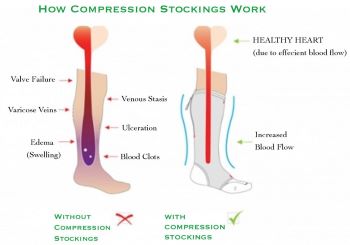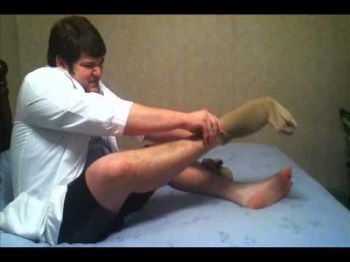The nursing profession and compression socks

Nurses, we all love our nurses, they are very important in today’s societies, they are there to provide patients with care, maintain composure and strength in critical situations and medical emergencies. The nursing profession is very demanding in more ways than one, nurses endure long hours on their feet, not only it is physically draining it is also a stressful job. Nurses are on the go all day, this means constant stress on the legs, which will increase the risk of varicose and spider veins appearing, especially in female nurses, many suffer from swollen legs, ankles and sore feet which is very uncomfortable when you are working long hours, this is why they are wearing compression socks.
There is an upside to nursing it can be a very rewarding job, helping people every day, helping patients regain their health, putting smiles on children’s faces and giving them a sense of assurance whilst sick and in care, this is all in a day’s work of a nurse.
Work Stress
Nursing can be a hazardous occupation, as a nurse, they work long hours and on their feet for most of the day, they are lifting and bending and repositioning patients constantly, this can cause different stresses physically particularly women, there is also the worry of exposure to infectious diseases. Emotional stress is a big problem amongst nurses, with the responsibility of medical procedures, long shifts, lack of sleep or just being there emotionally for the patients whilst they are in crisis.
Here are a few factors that may be experienced:
Fatigue from long hours

Nurses tend to be working long hours, during their shifts they are exposed to many situations and people, this can cause fatigue. Many nurses suffer from lack of sleep mainly from stress, these are important problems to be addressed, restless sleep form tired legs.
Back pain and musculoskeletal injuries

Back pain and joint problems can be caused by lifting and repositioning patients constantly, or simply just slipping or tripping in the wards can cause all kinds of health issues.
Exposure to infectious diseases

This is a very big problem amongst the nursing profession, especially in the ER’s when accidental exposure is experienced before diagnosis or treatment of the patients has been administered.
Varicose and spider veins and leg problems

Aching, swollen legs and sore feet are a common problem for nurses after long shifts. Varicose veins can be caused by years of being on your feet for hours at a time, and women tend to suffer from them more than men, the vessels can weaken and expand and this can cause pooling of the blood. Because of these problems nurses are now wearing compression garments to help them maintain leg health and manage problems that have already presented themselves, especially women nurses.
Injuries from sharps

Nurses are handling sharps (needles, scalpels etc) throughout their shifts on a daily basis and sometimes injuries can occur, due to accidents or lack of procedure.
Workplace violence
Unfortunately, nurses have to deal with agitated or aggressive patients who can become violent whilst under their care. Nurses and doctors can be victims of violence in the workplace, patients can be mentally unwell, under the influence of drugs, or just plain aggressive, so nurses can get badly hurt.
Exposure to hazardous chemicals

Nurses can be exposed to many chemicals on their shifts, radiation, chemicals used for sterilizing medical equipment, residue from various medications. Caution must always be exercised whilst handling these hazardous elements.
Dermatitis and skin allergies
This can occur from constantly washing your hands or allergies to lotions and creams. Some nurses suffer allergies from wearing surgical gloves, allergies can also happen with some compression socks.
Accidents in the workplace

Accidents are a problem in any workplace but the nurses can be exposed to many factors that can result in accidents, such as slipping, lifting patients, making beds, helping patients move about etc.
Let’s talk about compression socks for nurses.

Compression socks and stockings are a must for nurses these days, it helps them enormously. Compression socks can also be fun and fashionable to wear, there is a multitude of designs available that are colorful and fun. Gone are the days when the compression socks were boring and ugly and were generally worn by the older generation for their varicose veins, or whilst they were traveling, there were also the compression socks used solely for medical purposes, for example, post-surgery or treatment of venous ulcers etc.
Nurses like to wear compression socks that are colorful and fun, there are many designs to choose from, some can even help put a smile on a patient’s face especially the children. Compression socks can be bought either online or at various outlets, one of the websites is Compro Gear. It can also help lighten your mood donning your brightly colored compression socks, knowing your legs and feet are going to be comfortable throughout your day/night.

Everybody is wearing them now in the workplace, on-duty police officers, flight attendants, cashiers, nurses of course, these professionals are on their feet for most of the day. On the flip side you also have the people who spend the majority of the day sitting down, for example, truck drivers, taxi drivers, office workers, who all benefit from wearing compression socks.
There are many athletes and health enthusiasts that are wearing compression garments these days, they are used for various sporting activities, such as cycling, basketball, hikers, long-distance runners even golfers are now using them. Not only are they enjoying the comfort and support of the compression gear, but they are also benefiting from wearing them during exercise, as it aids with a quicker recovery because it helps to remove the lactic acid build-up and this reduces soreness of the muscles, some say it enhances their performance.
How do compression socks/stockings work?
The blood in your legs is constantly fighting against gravity, working constantly to get pumped back up to the heart. The compression socks work by giving firm support to your legs, the pressure on your legs and muscles helps to reduce the width of the large blood vessels, which in turn helps to increase the venous blood pressure in your veins. This makes it easier for the blood to be pumped back to the heart, where the blood is fed with nutrients and oxygen, and then pumped around the body feeding your muscles and organs.

The compression socks are generally made from 65% Nylon, 35% Elastane (Spandex), the socks are graduate as it goes from the ankle to the leg. They come in different compression levels ranging from 8mmHG to a medical-grade 50mmHG. The ratings are measured by the same system as a blood pressure test.
Note: The mmHG stands for millimeters of mercury, which is a manometric unit of pressure.
What mmHG level of compression sock do nurses wear?

The compression socks that are worn by nurses are generally 8 – 15mmHG or 15 – 20 mmHG.
8 -15mmHG – This the lowest level of compression and is used for people who have tired achy legs, slight swelling of the ankles, feet or legs by gently enhancing the flow of the blood to a more efficient pressure.
15 – 20mmHG – This level helps to alleviate moderate swelling and aching legs, it also gives relief from varicose veins. Many pregnant women are now wearing compression socks to help with the swelling of the legs and ankles in the later part of the pregnancy.
This level is what travelers generally use when going on long trips, either by car or plane it helps to prevent DVT (deep vein thrombosis) DVT can occur because you are sitting for long periods of time, therefore the blood has difficulty pumping the blood back to the heart efficiently, this can cause pooling of the blood which could then lead to a clot forming.
The higher levels of compression socks help alleviate problems like edema, Serious Venous Diseases such as Acute Leg/Ankle Swelling, Chronic Vein Insufficiency and DVT.
Getting your compression socks on

How do you get those tight compression socks on with ease? Support socks for nurses can be tough to put on yourself. Firstly find a comfortable chair to sit on, or even sit on the floor, preferably not on the edge of the bed as they don’t give much support. Make sure you have room to move freely, put your hand into the sock and start to turn it inside out until you get to the toe area, then place your toes inside the little pocket, then gently roll the sock up over your foot and up your leg until completely on and comfortable. Make sure there are not any wrinkles in the sock or stocking as this can cause irritation.
Tips:
- It is best to put your socks on first thing in the morning as your legs have rested overnight and the swelling would have decreased.
- You can also put talc on your legs to help slide them up easier.
- Take off your jewellry as they catch on the socks.
- If you have difficulty reaching your feet, then you can use a sock aid (place the sock on the device then slide your foot in, remove the device).
- You can wear latex gloves to help get your socks on.
- To remove the socks, you can just roll them down and pull off.
Biggest Tip of All: Never buy “One Size Fits All” compression socks. Just read the sock soothers reviews to see what a bad idea this is.
Cleaning your compression socks
Keeping your compression socks clean is very important in the nursing profession, whilst they are giving your legs the support they need throughout the long shifts, they could inadvertently come in contact with any kind of foreign matter, so it is imperative to keep them clean at all times to maintain cleanliness.

They can be machine washed on a gentle cycle or just hand washed in warm water with a mild detergent. Using a clothes dryer can deteriorate the elasticity in the garments, so it is better to hang them in the fresh air to dry. You should replace your compression socks about every 6 months, as the compression levels may deteriorate due to wear and tear, and you won’t be getting the full benefit from wearing them.
Fact: Did you know that according to the World Health Organization there are 20.7 million nurses around the world.

We have to thank our nurses for their tireless work, and they, in turn, can thank Engineer Conrad Jobst for inventing the compression sock. He suffered from venous ulcers in his legs and discovered whilst swimming in a pool his legs felt better because of the pressure of the water. Various other forms of compression have been used through the years for medical purposes but now we have the brilliant, colorful and purposeful compression sock to wear for work and play.
This page last updated January 7, 2022
